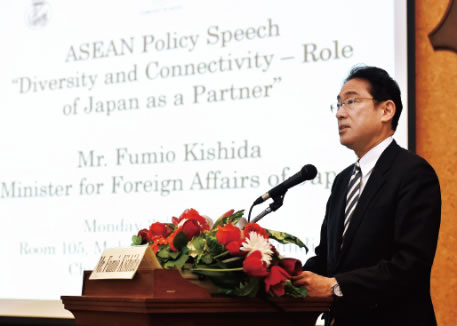ODA Topics 04
Connectivity in Asia
For sustainable development in Asia it is important to perceive growth from a perspective of “zones” rather than ”dots”, as the benefits of growth spread from individual countries to the region as a whole: the key is the connectivity.
Strengthening connectivity requires not only (1) physical connectivity through infrastructure development, etc., but also (2) institutional connectivity, such as the facilitation of customs procedures, and (3) people-to-people connectivity through human resources exchanges and the formation of networks. Advancing these three pillars as a trinity will create linkages among countries and active flows of people and goods across the region as a whole, resulting in “vibrant and effective connectivity.”
Japan’s cooperation does not stop after the building of roads or bridges, but rather it supports economic development of developing countries by creating flows of people and goods through infrastructure development, facilitating the shipment of goods and materials through the improvement of customs procedures at national borders, and developing communities in the vicinity of economic corridors with further acceleration of a flow of cooperation.
For example, “Tsubasa Bridge” in Cambodia, which was built by Japan’s support and opened to traffic in April 2015, is a strategic part of the economic corridor linking Phnom Penh and Ho Chi Minh. The opening of this bridge eliminated the need to wait for a ferry (sometimes up to seven or eight hours) to cross the Mekong River and has greatly contributed to invigorating economic activity in the vicinity. Furthermore, in India it was decided that Japan's High Speed Railways (HSR) technologies (the Shinkansen system) would be introduced to the HSR on the Mumbai-Ahmedabad route in 2015. Japan will provide the human resources development and transfer of technologies relating to the operation, maintenance and management of the high-speed rail system. This project is expected to reduce travel time between Mumbai, the second largest city in India, and the commercial city of Ahmedabad to approximately one-third of current time.
Another example is the case of the Port of Yangon in Myanmar, where JICA provided cooperation for the introduction of a customs system utilizing Japanese technologies. This cooperation has resulted in significant reduction of freight inspection time from at least two hours to less than one minute in the fastest cases. It is expected that the introduction of this system will enable the collection of appropriate customs tariffs and contribute to the facilitation of trade in Myanmar.
Japan is also supporting the enhancement of connectivity through assistance for human resources development in various countries for infrastructure management and maintenance. For example, through the provision of technical cooperation under the “Project for Improvement of Road Management Capability” in Vietnam, Japan makes efforts to provide assistance to human resources development to develop their skills for operation, maintenance and management of roads and is also engaged in measures that will complement connectivity.
In relation to these initiatives for improving connectivity, in May 2016 Minister for Foreign Affairs Fumio Kishida referred to “vibrant and effective connectivity” in the ASEAN policy speech focusing predominantly on the Mekong region at Chulalongkorn University in Thailand. In this speech Foreign Minister Fumio Kishida proposed the launch of a “Japan-Mekong Connectivity Initiative,” as a framework for realizing such vibrant and effective connectivity. In July the same year at the Japan-Mekong Foreign Ministers’ Meeting, this initiative was formally launched with the support of all countries in the Mekong region. At the Japan-Mekong Summit Meeting in September a list of ODA projects to be prioritized under the Japan-Mekong Connectivity Initiative was announced.
Strengthening connectivity is important from not only economic perspective, but also political and security perspectives. The key to peace, stability and prosperity in the international community is the dynamism that will be created through exchanges and interactions between the two continents of Asia and Africa and the two oceans of Pacific and Indian. The “Free and Open India and Pacific Strategy” announced by Prime Minister Abe seeks to enhance connectivity between Asia and Africa through the Indian and Pacific Oceans and promote stability and prosperity across both regions. The economic and strategic importance of these regions is extremely high and Japan will contribute further to stability and prosperity in the region.

Foreign Minister Fumio Kishida delivers a speech on ASEAN policy at Chulalongkorn University of Thailand in May 2016.
